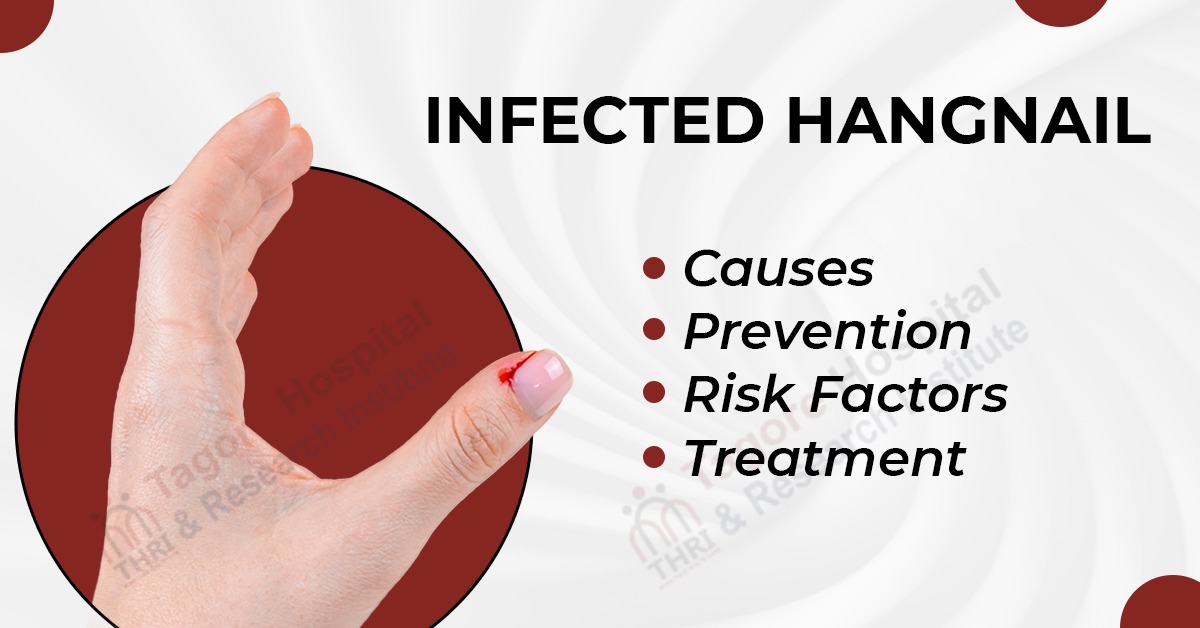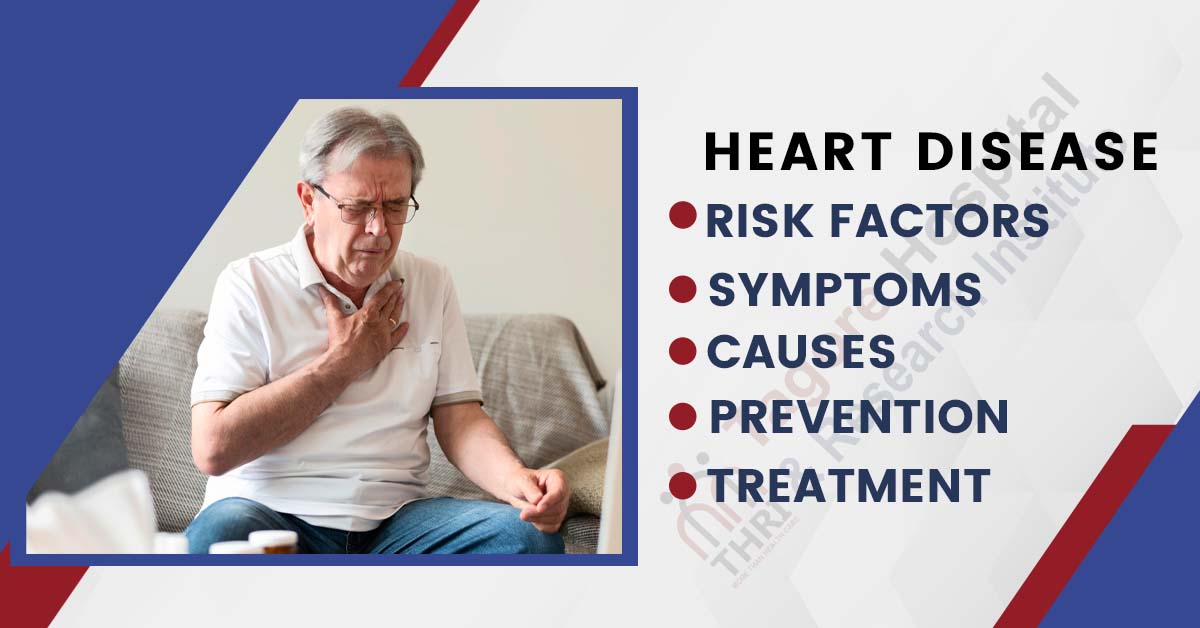- By Tagore Admin
- Posted April 21, 2023
The area around your fingernails may be irritated or infected if you experience pain there. However, you might have an infected hangnail if you have swelling and redness around your fingernail.
An area of skin that is torn and jagged-looking close to the nail's root is known as a hangnail. The majority of the time, hangnails affect the fingers rather than the toes, though they can occasionally occur around the toenail.
The conditions of an infected or ingrown nail and a hangnail are not the same. The skin on either side of the nail—not the nail itself—is what is referred to as the hangnail.
Most people have hangnails. In the winter and after extended periods of time in the water, hangnails are more common when your skin is dry. If a hangnail comes in contact with bacteria or fungus, it may become infected.
If your hangnail is infected, you should seek treatment in best hospital in Jaipur as soon as possible. A home remedy frequently works well in treating the condition. Your doctor should be consulted if the hangnail doesn't go away in a week.
How to identify Infected Hangnail?
Infected hangnail is also known as Paronchia. Where the nail meets the skin, a condition known as paronychia affects the surrounding tissue. When the nail becomes infected, it becomes inflamed and the surrounding tissue swells. This condition is known as onychia.
Usually, the toenail or fingernail's nail fold that is found on the bottom or edge swells up. The skin swelling, redness, and excruciating pain are all symptoms of inflammation. It may become pus-filled, appear yellow or white, or feel as though it is fluid-filled.
Your cuticle—the transparent skin that surrounds and lies above the bottom nail fold—may fall off if you frequently suffer from paronychia infections. As a result, the nail's hard nail plate lifts away from the skin in its immediate vicinity.
Even though the nail may fall off following an infection, once the infection has been treated, it usually grows back. The nail itself may thicken, turn discolored, or even become brittle if the infection is chronic.
Paronychias are also referred to by doctors as candidal paronychias. Between the nail plate and nail fold, there is typically a breach in the barrier. The yeast Candida albicans becomes infected as a result.
Pain in the toe region can be brought on by both paronychia and an ingrown toenail. They are two separate problems even though they can happen simultaneously.
When the nail plate extends into the skin around it, it results in an ingrown toenail, which can be inflammatory and infected. If left untreated, it can hurt and be uncomfortable.
Common signs include:
- redness
- swelling
- sensitivity to pain
- a warm feeling
- an inflamed area with a pus-filled blister
You Can Read also:- Pneumonia: Symptoms, Causes, Treatment, and Prevention
Causes of Infected Hangnail:
Conditions and things that irritate and dry out the skin are frequently to blame for hangnails. These include:
- dry air (which occurs more often in the wintertime when the air is cold and dry)
- using antibacterial hand gels with alcohol
- often washing your hands
- Biting or picking at one's fingernails
- engaging in pool swimming
When to see a doctor?
Schedule a visit with your doctor if any of the following apply:
- A week of home treatment doesn't result in an improvement of the affected area.
- The wounded area develops pus-filled blisters
- The beginning of infection symptoms in additional nail or finger areas
- Separation of the nail from the skin occurs.
- If you experience any additional strange symptoms, like a change in nail color or shape.
- You believe your hangnail may be infected because you have diabetes.
Infection-related symptoms will be checked by your doctor on your hangnail. By simply examining it, they might be able to identify the hangnail. In other situations, your doctor might decide to take a sample of any pus present in the infected area and send it to a lab for additional examination.
You might require a prescription for an oral or topical antibiotic. The infected area may need to be drained by your doctor if pus is present. Eradicating the bacteria may also help to lower localized pressure.
You Can Read also: Infected Stitches
Risk Factors of Infected Hangnail:
Some common risk factors include:
- Exposure to irritants: Some detergents and chemicals can cause skin irritation and infection of the nail bed. People exposed to chemicals and those who do not use protective gloves at work are at a higher risk.
- Age: With advancing years, nails become brittle and dry, cracking as a result. The immune system as well as the blood flow to the nails are both weakened.
- Biting nails or cuticles: Biting nails or picking at cuticles can cause minor skin damage or small cracks in the nails. These tiny abrasions can allow bacteria or fungi to enter the skin, which can lead to infections.
- Prolonged foot wetness: Due to sweating, athletes are more susceptible to fungus infections. Similarly, using public showers, gyms, and so on raises the risk.
- Skin issues: Infections like these are more likely to develop in people with underlying skin issues.
- Working with water: Bartenders and dishwashing workers whose hands are frequently in water are at a higher risk of having nail infections.
- Diabetes Mellitus: Diabetes mellitus, or any illness characterized by a weakened immune system, can also increase the likelihood of developing nail infections.
Diagnosis of Infected Hangnail:
The possibility of other nail issues exists in addition to fungus infections. As with fungal nail infections, other conditions can have a similar appearance.
Before prescribing an antifungal medication, your doctor should typically confirm your diagnosis through laboratory testing. The doctor may take a clipping of a nail to examine under a microscope or send it to a lab for testing to confirm the diagnosis.
Prevention of Hangnail from Infection:
To prevent a hangnail infection, you should:
- Do not chew or bite at your hangnails or nails. Don’t pick at your cuticles.
- Toe-nail trimming should be done with caution. Keep your scissors away from the nail fold when trimming cuticles.
- You can practice good hygiene by washing your hands frequently and maintaining neat nails. Make sure to use gentle soaps that won't irritate your skin.
- If your skin is dry, apply lotion to the area around your nails and cuticles. Skin cracking may result from extreme dryness.
- Wear waterproof gloves when handling chemicals to prevent your hands from remaining wet for an extended period of time.
You Can Read also:- Facts You Need To Know About Blood Cancer (Leukemia)
Treatments for Infected Hangnail:
You should think about seeking treatment from your healthcare provider if your symptoms are bothersome.
Warm soaks and topical antibiotics, such as Amoxicillin/clavulanate or fluoroquinolones, are used to treat nail infections brought on by bacteria. It might or might not be necessary to use topical steroids. Treatment for fungus nail infections can occasionally be challenging. The severity and kind of fungus that caused the infection will determine the course of treatment. Treatment for the condition could be protracted. Recurrent infections are also typical and must be observed if the nail condition improves.
Medications: Among the treatments for fungus infections are:
- Oral antifungal medications: Due to their quicker clearing of the infection than topical medications, these medications are frequently the first option. They include itraconazole (Sporanox) and terbinafine (Lamisil), both of which must be taken for 6–12 weeks.
By gradually replacing the infected nail's portion with new, infection-free nails, these medications aid in nail growth. However, the effects of the treatment won't be visible until the nail has fully grown. The removal of infection might take longer than four months. In patients over 65 years old, these medications' success rates are lower.
- Medicated nail polish: For infected nails and surrounding skin, an antifungal nail polish called ciclopirox (Penlac) may be recommended daily. After seven days, it can be wiped clean, the piled-on layers are washed with alcohol, and new applications are made. A one-year therapy period may be required.
- Medicated nail cream: In topical treatment, an antifungal cream is recommended, which is rubbed into the infected nail after it has been soaked for some time. These treatments may be more successful if the nails are first clipped and filed. This improves medicine penetration because the hard nail surface acts as a barrier to effective penetration of the underlying infection.
- Surgery: You might require an incision and drainage if an abscess forms. Surgeons may advise temporary nail removal in the case of persistent fungal infections so that the antifungal medication can be applied directly to the infected area beneath the nail.
When a fungal nail infection spreads, becomes severe, or becomes excruciatingly painful, a doctor may advise permanent nail excision because some fungal nail infections are drug-resistant.
Tags





